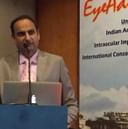Cataract - How to Reduce Your Risk?
We all have only a pair of eyes, so it is imperative that one understands the importance of vision. When the normally clear lens of one’s eye becomes clouded, the condition is known as cataract. A person suffering from cataract finds his vision to be hazy, discoloured and blurred somewhat like looking outside a frosted window. It causes difficulty in reading, driving a vehicle or seeing the familiar expression on a loved one’s face.
It is a silent killer of vision and initially magnification and lighting in addition to vision aids are helpful, but eventually a surgery becomes imminent.
The exact reason for cataract are debatable, but one can take measures to protect oneself, boost one’s eyes’ defence mechanisms, and protect them from harmful elements. Ultra violet (UV) light has been correlated with incidents of cataract and has a damaging effect on one’s eyes. This requires one to wear sunglasses that block ultraviolet B (UVB) rays when one is outdoors. Smoking also increases the risk of cataract thus giving one another reason to stay away from active as well as passive smoking.
One must include antioxidants as zeaxanthin, vitamin C, lutein and vitamin A in daily diet to counteract with the daily damage. The addition of a variety of fruits and vegetables to one’s diet ensures that one is getting many vitamins and nutrients. The health of the eyes can be maintained with fruits and vegetables as they have many antioxidants. One must go for eye examination to ophthalmologists in a time bound and regular manner so to detect the onset of cataract at the earliest.
One must maintain a healthy weight by reducing the calorie intake. Excessive consumption of alcohol also increases the risk of cataract. If one is suffering with other health conditions like hypertension and diabetes, it becomes all the more important that one must follow the treatment plan diligently. The exposure to ionizing radiation like X-rays and cancer treatment via chemotherapy increase the risk of cataract.
Cataract develops when aging or injury changes the tissue that makes up one’s eye's lens while some cataract are due to inherited genetic disorders causing other health problems. In some cases eye conditions, medical conditions such as diabetes, long term usage of steroids, trauma or past eye surgery also leads to cataracts.
As one ages, the eye lenses become less flexible, less transparent and thicker. Ageing causes break down and clumping together of tissues within the eye lens leading to clouding small areas within the lens. As the cataract continues to develop, the clouding becomes denser and involves a greater part of the lens. Thus, although one cannot prevent cataract, but if one takes the above mentioned steps, then he can reduce the risks of getting it. If you wish to discuss about any specific problem, you can consult an Ophthalmologist.



+1.svg)
